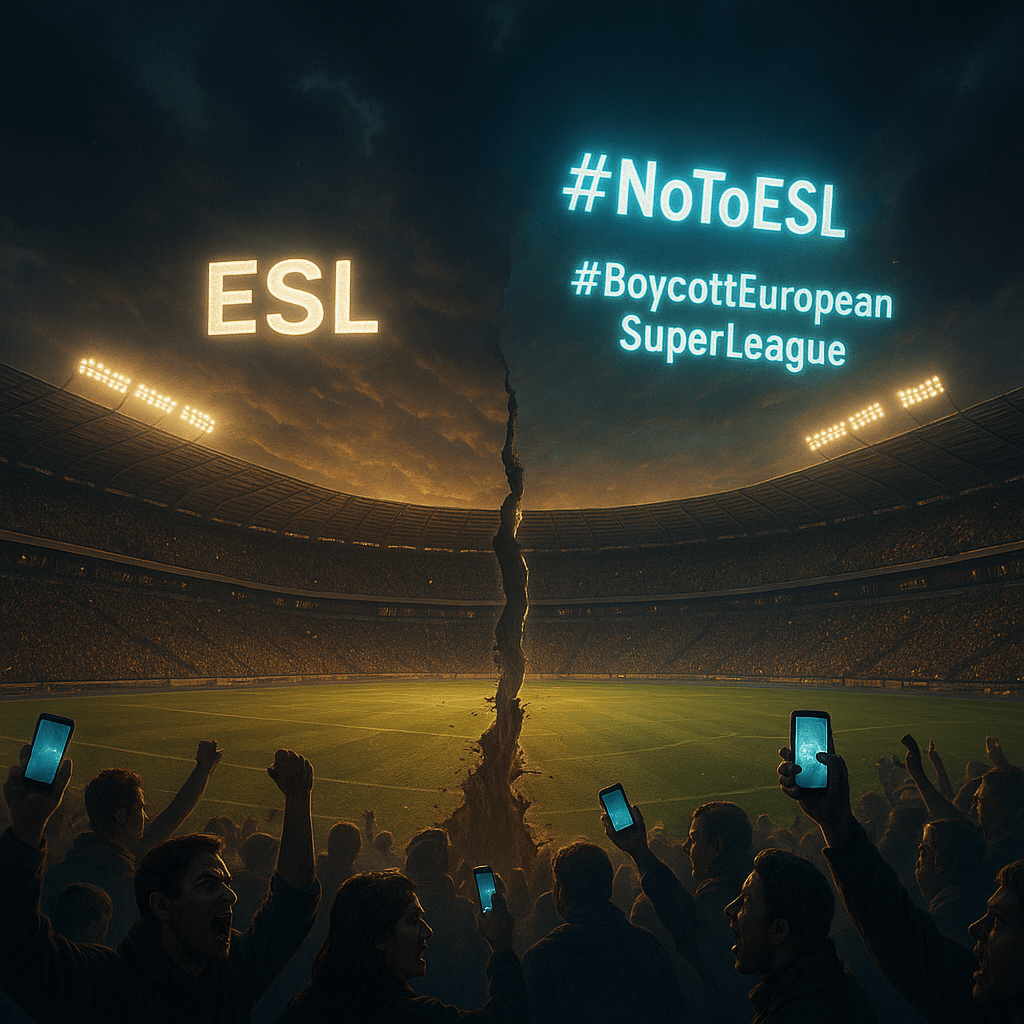When twelve of Europe’s wealthiest and most famous football clubs announced the launch of the European Super League (ESL) in April 2021, the expectation was fanfare and celebration. Instead, what followed was an extraordinary backlash. Within just 48 hours, most clubs retreated from the project after facing an online storm, much of it concentrated on Twitter, now X.
The rapid collapse of the ESL was not just a sports story. It was a communications crisis, a case study in how digital publics can overpower corporate strategies. A recent study, titled Understanding organisation public relations through Twitter communication for the European super league published in European Sport Management Quarterly by Manoli, Anagnostou, and Kolyperas sheds light on this episode, revealing important lessons about organisational public relations (OPR), fan engagement, and the evolving role of social media.
A storm born on twitter
For decades, public relations relied on one-way communication. Organisations crafted press releases or statements, and the public received them with little scope to respond. Feedback loops were limited and often delayed. Social media changed this dynamic, turning monologues into conversations.
In sport, where loyalty and identity are deeply personal, this shift proved explosive. The ESL announcement was sterile and corporate, framed in a top-down manner that ignored fan voices. Clubs used Twitter as a megaphone rather than a platform for dialogue. Messages were emotionless declarations, offering no space for fans to participate.
Fans reacted immediately. Within hours, hashtags such as #BoycottEuropeanSuperLeague and #NoToESL dominated Twitter. They targeted not only the concept of the league but also the owners of individual clubs. Replies to official tweets brimmed with anger:
“Disgusting. This isn’t the club I’ve supported all my life.”
“You’ve ruined the relationship between the fans. Time to go.”
“One of the darkest days in this club’s history.”
Over 128,000 replies to just ten club tweets reflected betrayal, fury, and the perception of being ignored. Clubs had not merely made a poor business decision. They had violated what many supporters saw as a social contract.
Power of collective outrage
The ESL crisis illustrated how fans, united across club rivalries, could wield extraordinary influence online. Supporters praised the few clubs that issued apologies, with Arsenal’s statement standing out as at least a partial attempt at dialogue. Rival fans acknowledged these rare moments of transparency, showing how tone and sincerity shape trust.
Notably, supporters generated their own dialogue on Twitter. They debated, celebrated withdrawals, and collectively pushed back against what they saw as football’s corporate overreach. Their conversations exposed a missed opportunity for clubs: the chance to engage directly and openly with stakeholders.
This was more than sport. It was an example of collective online action altering the course of business decisions. Similar patterns can be seen in climate activism campaigns, brand boycotts, and political movements where publics demand accountability.
Modelling from column studies to community filters
To simulate real-world use, the researchers conducted continuous column experiments. Variables such as bed height, flow rate and inlet fluoride concentration were systematically tested. At a 30 cm bed height, with a flow rate of 10 litres per day and an initial fluoride concentration of 3 mg/L, the system achieved a maximum of 1415 bed volumes before breakthrough.
These results confirmed the scalability of the technology. Unlike many lab-scale experiments that remain theoretical, this research moved swiftly towards practical implementation.
What we can learn from the way in which the ESL crisis unravelled in Twitter, is that sterile, formal, corporate communications do not work when addressing loyal, passionate and engaged football fans. I would argue that loyal and engaged customers of any industry should indeed be viewed as informed and important stakeholders of the companies, and as such invited to discuss and not just receive news about the company they support and engage with. Social media can be the best tools in this effort to truly engage with dialogue with such publics and as such it is about time they are taken more seriously by organisations
-Elisavet
The 4I framework
To analyse the events, the study introduced the 4I Framework (referred to in he table below), which categorises public relations based on communication direction and stakeholder concern.
Domain | Communication | Concern | Description |
|---|---|---|---|
Informative | One-way (org → public) | Self-interest | Sterile, emotionless announcements. |
Insinuating | One-way (org → public) | Public interest | Appear to care, but still no real dialogue. |
Insulating | Two-way (fan ↔ fan) | Fan interest | Fans talk among themselves; clubs stay silent. |
Inspiring | Two-way (all directions) | Shared interest | Ideal: transparent, responsive, real-time communication. |
Most ESL communication fell into the informative or insinuating categories. Clubs announced their plans and later their withdrawals, but with little genuine engagement. Arsenal’s apology leaned toward insinuating, yet authentic inspiring communication was absent.
This framework reveals a broader lesson: organisations often reduce Twitter to a broadcasting tool, while stakeholders seek genuine dialogue. The gap between these expectations can erode trust and legitimacy.
Silence is not neutral
One of the striking features of the ESL crisis was that clubs did not block comments or replies. They allowed responses but chose not to engage with them. This created what researchers describe as a lack of a dialogic loop. Platforms designed for interaction became noticeboards, while fans filled the silence with their own debates.
As lead author Argyro Elisavet Manoli observed, “dialogue without participation is not relationship-building. Clubs facilitated the platform, but not the conversation. In other words, conversation did happen because of them, but clubs chose to refrain from it.”
The absence of dialogue sent its own message: silence was interpreted as disregard. In public relations, ignoring stakeholders can be as damaging as saying the wrong thing.
Why this matters beyond football
Although rooted in football, the ESL story offers lessons for governments, corporations, universities, and other institutions. In each case, the relationship between organisations and their stakeholders is shifting under the weight of digital technologies.
The ESL collapse demonstrates how publics no longer act as passive audiences. They are active participants who can derail strategies and demand accountability. Whether in debates about climate change, political corruption, or corporate ethics, online communities amplify collective power.
For institutions, this signals that public relations must move beyond one-way communication. Honest dialogue, transparency, and responsiveness are essential. The age of message control is fading.
The emotional cost of corporate style
Another lesson from the ESL crisis is the failure of emotionless corporate language. Announcements written in a detached, managerial tone clashed with the emotional intensity of football fandom. Clubs treated supporters as customers, while fans saw themselves as part of the club’s very identity.
This mismatch fuelled outrage. Fans did not want transactional updates. They wanted to feel respected as partners in the club’s journey. The sterile language of corporate PR created distance rather than connection, eroding the emotional bond that underpins loyalty.
The lesson extends beyond sport. In industries where trust and identity matter, robotic corporate tones risk alienating publics. Language that acknowledges emotions, mistakes, and shared values fosters credibility.
From sport to wider society
The implications of this case extend into multiple domains. Universities facing student protests, companies navigating consumer boycotts, and governments addressing public health crises all encounter similar dynamics.
Publics expect dialogue. They demand seats at the table. Organisations that ignore this reality invite backlash. The ESL collapse is a vivid reminder of what happens when communication strategies lag behind social expectations.
In the digital age, silence or one-way messaging is not merely outdated. It is dangerous. Stakeholders are no longer passive. They are empowered actors who can mobilise, organise, and influence outcomes at speed.
Lessons for organisations and policymakers
The ESL case provides several insights for leaders and policymakers:
- Silence is costly: Choosing not to respond can be as damaging as an ill-judged statement.
- Social media is not a press release channel: It requires interaction and responsiveness.
- Tone matters: Emotionless communication erodes trust, while transparent dialogue fosters it.
- Stakeholders shape outcomes: In sport, politics, or business, publics can derail strategies if excluded from conversations.
- Frameworks help: Tools such as the 4I Framework provide a structure for evaluating and improving communication.
Ultimately, dialogue is no longer optional. It is a necessity.
The age of inspiring communication
The collapse of the European Super League was more than a failed business plan. It was a vivid demonstration of how power relations have shifted in the digital age. Fans, once dismissed as background noise, became decisive actors. Their online revolt revealed the potential of collective action and the risks of ignoring stakeholders.
For football clubs, corporations, and policymakers alike, the message is clear. Social media is not a megaphone. It is a forum. The organisations that thrive in this environment will be those that embrace inspiring communication: transparent, responsive, and emotionally intelligent.
The ESL saga is a reminder that in the age of digital publics, controlling the message is no longer possible. Listening, engaging, and respecting stakeholders is the only path to sustainable trust.
Reference
Manoli, A. E., Anagnostou, M., & Kolyperas, D. (2025). Understanding organisation public relations through Twitter communication for the European super league. European Sport Management Quarterly, 1-18. https://doi.org/10.1080/16184742.2024.2442579







